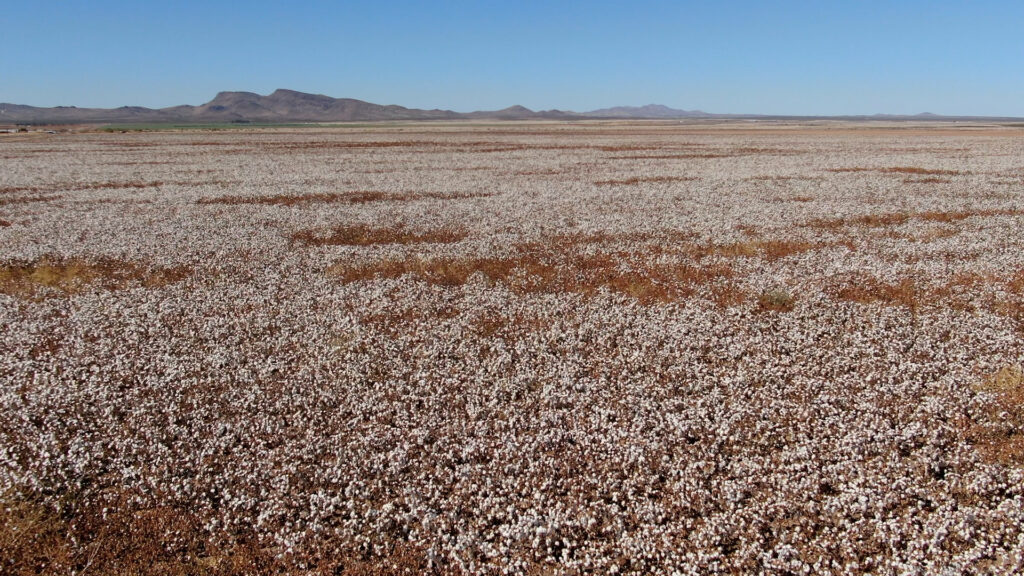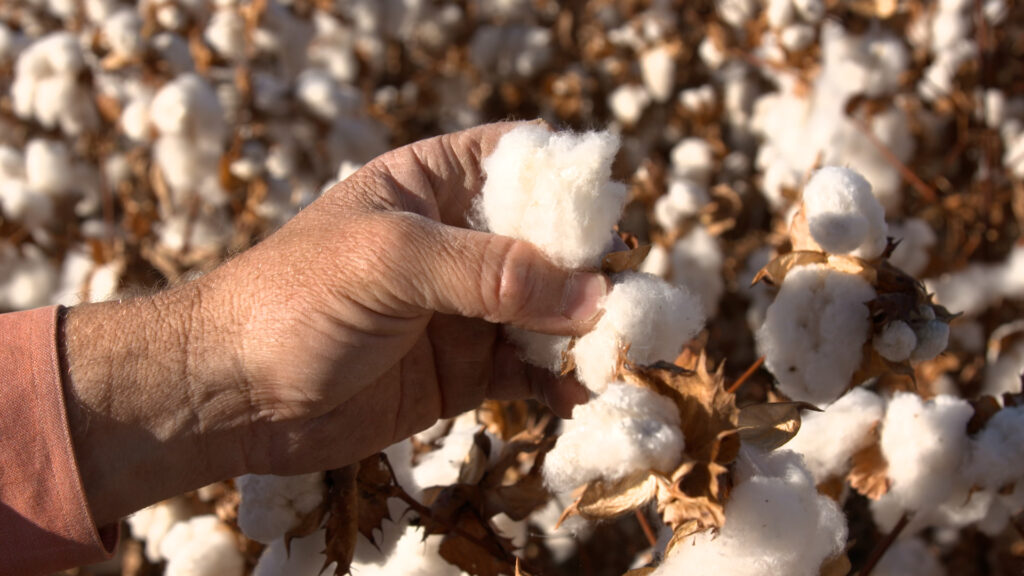A Regenerative Cotton Grower’s Journey
It was August of 2018 when I first sensed that I needed to make some changes to the way I farmed.
Yields had been in steady decline and, more importantly, profitability seemed like a distant memory. I was under constant turmoil and stress. Why could I not get my performance back to where it was 10 to 15 years ago? I agonized year after year trying to make sense of my predicament. I had followed my agronomist’s recommendations to a T! I had applied the correct fertilizers, seed treatments, insecticides, herbicides and fungicides, but even with all my best inputs I was losing every battle.

A board representative position that I serve on had brought a new group of peers into my life, one of them being from southeast Missouri. He quizzed me about our fertility program, what we were doing culturally, and how I felt about my results. After conveying to him my misery, he shared his experience utilizing Kinsey Ag’s program of soil amendments, and he thought they might be able to help.
September of that year he visited my farm with a soil consultant. We looked, smelled, sampled and discussed what was right and what was wrong. At the time, we used quite a bit of dairy manure-based compost, thinking that was our best bet to fix our soils. He asked a friend of mine using similar sources for an analysis of what was being applied, and we found that our compost had 160 pounds of potash equivalent per ton. By using 5 tons of compost per year on most of our already high K soils, we had unknowingly applied enough K to alter our weed pressure and block out multiple other nutrients.
We had no idea of any of this until a comment was made by this soil fertility specialist about field bindweed and the calcium-to-potassium ratio. Our area was eaten up with bindweed by the fourth year of compost applications, and it mostly came down to too much potassium. The question was posed about what my friend was doing to control his bindweed, and the reply was up to a gallon of roundup per acre. The consultant then commented, “Do you have any idea what that rate does to mycorrhizae?” This sent me down an all-night-long rabbit hole of glyphosate research.

The next indicator came during a conversation later that year. I had been cold-called by a couple of organic consultants traveling from El Paso to a meeting in Phoenix. I just so happened to be an easy stop on the route they chose to take that day. We stood on the edge of a newly emerged onion field and discussed what our current practices were. I told them that I had started looking into a few new technologies, one of which was a soil moisture sensor that had what I thought was a great disease model built in. They asked what my target was in the model, and I explained that we struggled with powdery mildew.
One of them then asked, “Who tells the model about the calcium nitrate application and timing?” I was perplexed. I was the cooperating grower on a University of Arizona study about the benefits of using calcium nitrate in peppers; how could that be possibly be the cause of my outbreak? I was quickly schooled about the effect of nitrate on a plant. This cost me another sleepless, but profitable, night of research. (I love the research that can be done on the internet, until I realize that it’s two in the morning and I have to be up at six!)
The final nail came in March of 2020, when my oldest son and I attended a cotton growers’ school put on by John Kempf. I had been listening to John’s podcasts, and most of what I heard in that first year just didn’t add up. It wasn’t until I listened in person that I came to the realization that we were our own worst enemy! Most of my issues on the farm were self-inflicted. Over the course of many years of subsurface drip irrigation we had degraded our soil biology to a point that it was probably nonexistent. I took notes, pondered, and racked my brain at the thoughts of the changes that needed to be made at home. Later that night, as we drove the seven hours home, I made the decision that we couldn’t afford to continue the way we were farming — we had to go all in on regenerative production or go out of business.
Cotton on our farm had historically been grown with a large volume of various applications. Phosphate and nitrogen were both applied preplant, but our soils were high in K, so none was applied. Starting at pin head square — the first sign of fruiting position — we usually started applying a plant growth regulator (PGR). Most cotton growers put on about 8 ounces of mepiquat chloride at that point and then continue to apply it, at a similar or higher rate, every 10 to 14 days until early September.
John pointed out several flaws with this scenario during that day-long education. His first lesson was on soluble phosphate. He asked the group what the common application was, and for ease of math it was 200 pounds of 11-52 monoammonium phosphate (MAP). He then asked what amount of actual phosphorus we got from this. Most of the group, including me, assumed that it was 52 percent of 200 pounds — 104 pounds. However, John explained that most of this product is in the oxide form and that the 52 percent is P205, which is 43 percent actual phosphorus. This P is not plant available; the true plant-usable P gained was probably in the neighborhood of three pounds. That’s a pretty expensive three pounds of P if you ask me!

The second lesson was on preplant or early-season N application. Without a green plant there to catch the CO2, it most likely burned off our soil carbon and/or released a large amount of it back into the atmosphere. N needs are very low in a small cotton plant, so why were we applying it?
The third lesson was about the overuse of PGRs. Most cotton growers are driving a car with one foot on the gas (N) and one on the brake (PGRs).
Soil is resilient! Biology in soil can be built back, and this can be done in a rapid fashion! We now apply soil primers, which consist of biological inoculants, food for those and already existing soil microbes, and minerals and humic substances. At times, we take the opportunity to add in a few specific micronutrients, if needed. This is the keystone of our program: support the life and diversity in the soil biome first. We inoculate all seeds to be planted with mycorrhizal fungi. This is one of the easiest and cheapest things we can do. We pull plant sap analysis as soon as we have a full-grown true leaf to see where we stand on a long list of measurables, including total sugar (measurement of overall health), pH, macronutrients, and many micros. Why would we guess when we can test?
Our goal is to keep nitrate as close to zero as possible, and our ammonium on the low side, while keeping total N levels adequate. We strive to fix N from the atmosphere rather than paying for it from a dealer. We push our vegetative growth more through calcium than from relying on huge shots of N. We also regulate the plant growth by making sure our natural plant hormones are balanced and in check. By analyzing plant sap, we have learned the importance of boron, manganese, cobalt, molybdenum, iron and copper. None of these products were even looked at in the old way of growing cotton. Like the Kinsey system of soil, we were now looking at total mineral balance, but this time it is in the plant. The immediately learned what we had been applying in excess, and what that excess had affected.
What kinds of results have we seen? This program has given us plants so resilient that we have not had to apply an insecticide on any of our farms since June 2020. It has given us plants that are operating at an increased level of photosynthetic capacity and that it are now feeding the soil biology through an increase in exudates — increasing soil organic matter as well as soil carbon in the process. It has made plants so strong and so resilient that we have had no need to apply fungicides to control things like southwest cotton rust or powdery mildew. By year three, we had reduced our overall N application to 11.5 units. We apply zero phosphates or plant growth regulators. All of this while increasing our yields on the whole farm to 50 percent higher than our county average, with a farm-best yield of about a 150 percent increase.
I thought organic production was impossible here in the high desert of southwest New Mexico, but it turns out I was just one input change away from making it a reality. With that, I’m happy to say we certified our first organic acreage in the spring of 2021 and are currently midway through our second season of growing organically.
Our journey into regenerative has shown us that plants and soil are both resilient and able to be healed. The mistakes of our past don’t have to haunt us forever — they can be fixed. Sometimes the hardest change to make is in the grey matter we call our minds.
James Johson is the Vice President of Carzalia Valley Produce in New Mexico.













